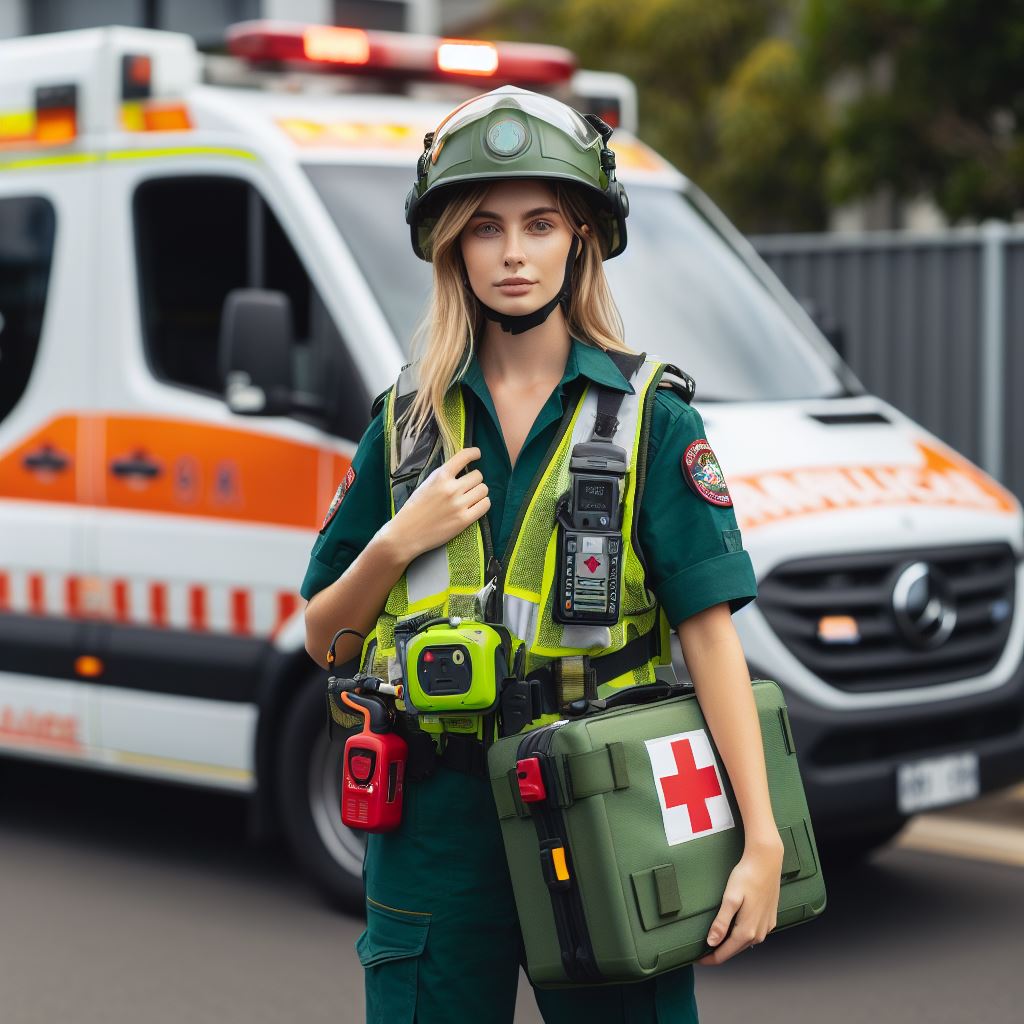Introduction
Physical fitness for Australian paramedics plays a crucial role in their ability to provide effective emergency medical care.
Paramedics often face physically demanding situations that require strength, agility, and endurance. Being physically fit allows them to meet these challenges and perform their duties effectively.
This blog post aims to discuss the significance of physical fitness for Australian paramedics and provide insights on how they can maintain a healthy and fit lifestyle.
Being physically fit is not only important for paramedics’ own well-being but also directly impacts their ability to assist patients in emergency situations.
This blog post will explore the various aspects of physical fitness that are crucial for paramedics in Australia and offer practical tips for maintaining a healthy and fit lifestyle.
For Australian paramedics, maintaining optimal physical fitness is crucial, enabling effective response to emergencies, provision of critical care, and ensuring patient safety and well-being.
Additionally, being physically fit reduces the risk of injuries and enhances overall job performance and job satisfaction.
This blog post deepens paramedics’ fitness understanding, introduces enhancing exercises, and provides lifestyle and nutrition tips for overall health.
Overall, this section aims to inspire and empower Australian paramedics to prioritize their physical fitness, leading to improved performance on the job and a healthier, more fulfilling life.
Importance of Physical Fitness for Australian Paramedics
The Physically Demanding Nature of the Paramedic Profession
- Paramedics face physically challenging situations on a daily basis.
- They must lift and maneuver heavy equipment, stretchers, and patients.
- Paramedics often work in high-stress environments, requiring quick decision-making and physical agility.
- They may have to perform CPR for extended periods, requiring strength and stamina.
- Emergency situations can be unpredictable, requiring paramedics to be physically prepared for any scenario.
How Physical Fitness Enhances Job Performance and Patient Care
- Physical fitness allows paramedics to perform their duties efficiently and effectively.
- Good cardiovascular fitness improves stamina, enabling paramedics to provide continuous care during emergencies.
- Strength training helps paramedics lift and carry patients without causing injury.
- Flexibility enhances range of motion, enabling paramedics to provide optimal care to patients.
- Endurance training ensures paramedics can handle long hours on duty without exhaustion.
- Physical fitness enables paramedics to respond quickly and safely to emergency situations.
Specific Physical Requirements for Paramedics in Australia
- Paramedics in Australia must meet specific physical fitness standards.
- These standards assess cardiovascular fitness, strength, flexibility, and agility.
- Paramedics must be able to perform physical tasks such as patient transportation and CPR.
- The physical fitness requirements aim to ensure paramedics can handle the demands of the job effectively.
The Correlation Between Physical Fitness and Mental Well-being
- Physical fitness is closely linked to mental well-being.
- Regular exercise releases endorphins that promote positive mood and reduce stress.
- Paramedics who are physically fit are more likely to handle the mental and emotional challenges of the profession.
- Physical fitness helps reduce the risk of burnout and improves resilience in high-stress situations.
- Maintaining physical fitness also helps prevent injuries, allowing paramedics to stay mentally focused on their work.
Basically, physical fitness is of utmost importance for Australian paramedics. The physically demanding nature of their profession requires strength, agility, and the ability to make split-second decisions.
Physical fitness enhances job performance, improves patient care, and contributes to mental well-being.
Paramedics must meet specific physical requirements to ensure they can handle the demands of the job effectively.
By prioritizing physical fitness, paramedics can excel in their roles and provide the best possible care to those in need.
Read: Emerging Trends in Healthcare Administration
Benefits of Physical Fitness for Australian Paramedics
Improved Stamina and Endurance
- Engaging in regular physical fitness activities improves cardiovascular health and allows paramedics to maintain stamina and endurance during long shifts.
- A higher level of stamina and endurance enables paramedics to respond effectively to emergencies with sustained energy and reduced fatigue.
- Better cardiovascular fitness also aids in the prevention of heart disease, a common health concern for paramedics.
- Paramedics with improved stamina and endurance can handle the physically demanding aspects of their job with greater ease.
- Regular exercise sessions, such as cardio and interval training, enhance paramedics’ overall fitness and increase their capacity to perform duties effectively.
Enhanced Strength and Mobility
- Physical fitness exercises, including strength training, improve muscle strength and overall body composition.
- Enhanced strength enables paramedics to safely lift and transport patients more efficiently, minimizing the risk of musculoskeletal injuries.
- Exercises targeting core muscles improve stability, balance, and coordination, allowing paramedics to move more efficiently during emergencies.
- Paramedics with improved mobility can navigate challenging terrains and access patients in difficult, confined spaces effectively.
- Stronger muscles and increased joint flexibility also reduce the risk of chronic pain and improve posture, preventing long-term injury.
Increased Mental Focus and Alertness
- Physical fitness activities promote the release of endorphins, leading to improved mood and mental well-being.
- Regular exercise boosts brain function, memory, and cognitive abilities, allowing paramedics to make critical decisions quickly and accurately.
- Increased mental focus and alertness result in better situational awareness and the ability to respond effectively in high-pressure situations.
- Paramedics with better mental acuity can anticipate potential risks and make accurate assessments, enhancing patient care.
- Regular exercise also helps alleviate stress and anxiety, promoting mental resilience and emotional well-being.
Reduced Risk of Injuries on the Job
- Physical fitness training strengthens bones, ligaments, and tendons, reducing the risk of injuries during physically demanding tasks.
- Stronger muscles provide better support to joints, decreasing the likelihood of sprains, strains, and fractures.
- Improved flexibility helps prevent muscle imbalances and overuse injuries, which are common among paramedics.
- Paramedics with adequate physical fitness have a better chance of avoiding falls and other accidents while on duty.
- Reducing the risk of injuries enhances paramedics’ longevity in their careers and overall job satisfaction.
Better Ability to Handle Stressful Situations
- Regular physical fitness activities equip paramedics with effective coping mechanisms to handle the high-stress environment they work in.
- Exercise reduces the impact of stress hormones, increasing resilience and improving long-term mental health.
- Physical fitness training also improves sleep quality, allowing paramedics to recover and recharge more effectively.
- Paramedics with better stress management skills can remain calm and focused in stressful situations, providing optimal patient care.
- Better overall fitness contributes to overall well-being and a sense of personal control over one’s physical and mental health.
Read: Interviewing Healthcare Admins: Real Stories
Strategies to Maintain Physical Fitness
Maintaining physical fitness as an Australian paramedic is crucial for ensuring optimal job performance and overall well-being.
By implementing the following strategies, paramedics can enhance their physical fitness levels and effectively manage the demands of their profession.
Regular exercise routines
Regular exercise is essential for paramedics as it helps improve cardiovascular endurance, muscle strength, and flexibility. Including a variety of exercise types in their routine is recommended:
Cardiovascular exercises
Engaging in activities such as running, cycling, or swimming can improve endurance and strengthen the heart.
These exercises also support weight management, reduce the risk of chronic diseases, and boost overall energy levels.
Strength training
Strength training exercises, like weightlifting or resistance training, are crucial for building and maintaining muscle strength.
Strong muscles not only improve performance during physical tasks but also contribute to injury prevention and healthy aging.
Flexibility exercises
Performing stretches and exercises that target flexibility is vital for paramedics who often need to move in challenging positions.
Improved flexibility reduces the risk of muscle imbalances and injuries, allowing paramedics to perform their duties effectively.
Proper nutrition and hydration
A well-balanced diet and adequate hydration are key components of maintaining physical fitness:
Your Personalized Career Strategy
Unlock your potential with tailored career consulting. Get clear, actionable steps designed for your success. Start now!
Get StartedBalanced diet
Paramedics should follow a diet rich in fruits, vegetables, lean proteins, and whole grains.
These foods provide essential nutrients, vitamins, and minerals that support overall health and provide the energy needed for demanding work shifts.
Adequate water intake
Staying properly hydrated is crucial for paramedics who often work in physically demanding environments.
Drinking enough water throughout the day helps maintain fluid balance, regulate body temperature, and support optimal physical and cognitive function.
Sufficient rest and recovery
Rest and recovery are essential for allowing the body to repair and recharge:
Importance of quality sleep
Paramedics should prioritize getting enough sleep to ensure proper physical and cognitive function.
Quality sleep promotes muscle recovery, enhances mental alertness, and reduces the risk of accidents or errors during shifts.
Incorporating rest days into the fitness routine
It is important for paramedics to incorporate rest days into their exercise routines.
Rest days allow the body to recover, reduce the risk of overuse injuries, and prevent burnout, helping maintain long-term physical fitness.
Mental health and stress management
Maintaining mental well-being is crucial for paramedics, given the stressful nature of their work:
Techniques for relaxation and stress reduction
Paramedics can practice relaxation techniques, such as deep breathing exercises, meditation, or yoga, to manage stress levels.
These techniques can help reduce anxiety, promote mental clarity, and enhance overall well-being.
Seeking support when needed
Paramedics should not hesitate to seek support from colleagues, friends, or professional services when experiencing mental health issues or high levels of stress.
Sharing concerns and seeking appropriate help can contribute to a healthier work-life balance.
By implementing these strategies, Australian paramedics can maintain their physical fitness levels, enhance job performance, and improve overall well-being.
Prioritizing regular exercise, proper nutrition and hydration, sufficient rest, and mental health management will support paramedics in effectively meeting the demands of their challenging profession.
Read: Career Path: Growing as a Healthcare Admin

Engaging in Physical Fitness as a Paramedic Community
Encouraging teamwork in fitness activities
- Participating in fitness activities as a team can foster camaraderie and motivate paramedics.
- Engaging in group exercises such as circuit training or relay races can boost morale and unity.
- Teamwork in physical fitness activities can also improve communication and trust among paramedics.
Organizing fitness challenges or events
- Hosting fitness challenges or events can provide a fun and competitive atmosphere for paramedics.
- Activities like obstacle courses or fitness competitions can offer opportunities to showcase individual skills.
- Organizing events can also create a sense of excitement and encourage participation in physical fitness.
Promoting a positive and supportive fitness culture
- Creating a positive environment that supports and encourages physical fitness is crucial.
- Paramedic leaders can emphasize the importance of maintaining a healthy lifestyle to inspire others.
- Ensuring that fitness resources and facilities are easily accessible further promotes a supportive culture.
Sharing success stories and inspiring experiences
- Sharing success stories and inspiring experiences can motivate paramedics in their fitness journeys.
- Personal accounts of overcoming physical challenges can demonstrate the potential for improvement and growth.
- Highlighting achievements can also encourage others to strive for their own fitness goals.
By embracing physical fitness as a paramedic community, there are numerous benefits that can be achieved. Engaging in fitness activities together promotes teamwork, communication, and trust among paramedics.
Organizing challenges or events adds a competitive element and fosters a sense of excitement and participation.
Additionally, promoting a positive and supportive fitness culture ensures that paramedics have access to resources and facilities that cater to their physical well-being.
Sharing success stories and inspiring experiences further motivates paramedics to prioritize their own fitness goals.
Ultimately, engaging in physical fitness as a paramedic community enhances overall well-being and helps develop a strong and cohesive team.
Read: Healthcare Management: Degrees in Australia
Conclusion
Australian paramedics, recognize the pivotal role of physical fitness – a cornerstone for optimal performance in the face of demanding emergency situations.
It is not merely a recommendation but an indispensable component of your professional toolkit.
Delve deeper into the benefits. A physically fit paramedic experiences heightened resilience, diminished risks of injury, and improved mental well-being.
These elements collectively contribute to sustained effectiveness in the challenging realm of emergency response.
Stand Out with a Resume That Gets Results
Your career is worth more than a generic template. Let us craft a resume and cover letter that showcase your unique strengths and help you secure that dream job.
Get HiredThe imperative is clear: prioritize your health and well-being.
A physically fit paramedic is not only more adept at handling the physical demands of the job but is also better equipped to navigate the mental and emotional toll.
Let this resonate as a call to action. Integrate fitness into your daily life, transforming it from a recommendation to a personal and professional commitment.
By doing so, you not only invest in your own longevity and wellness but contribute to a culture of health and resilience within the paramedic community.




